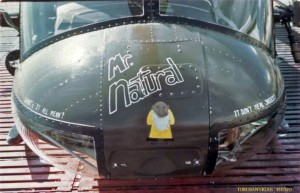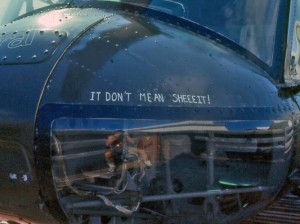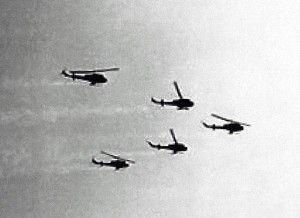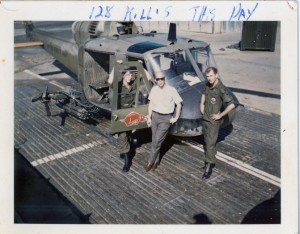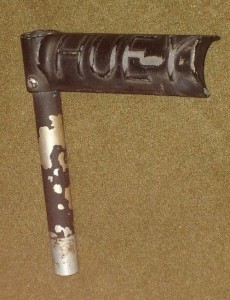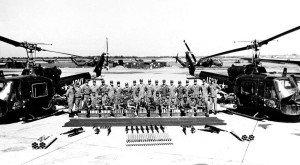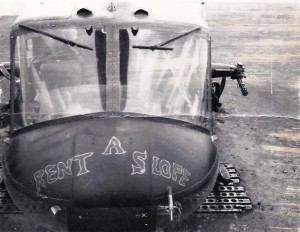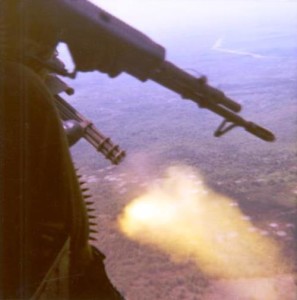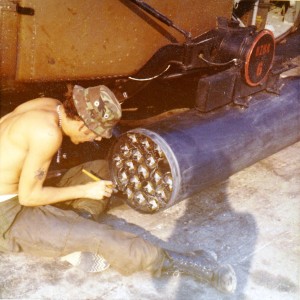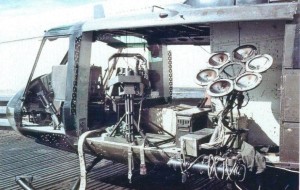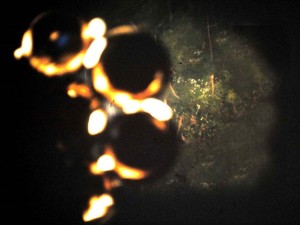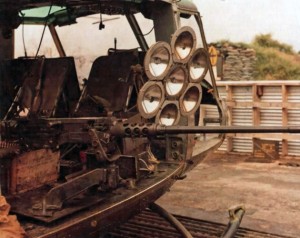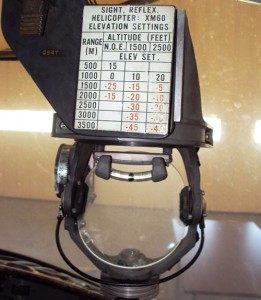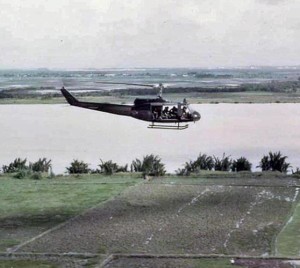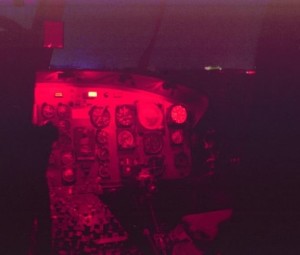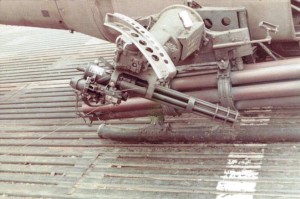The Razorbacks flew several different helicopters throughout the years. Each had it’s own personality and idiosyncrasies. Their armament and sub-systems varied as well. Our old Bravo models were often mistaken for Charlies because of the engine cowling and Charlie Model tail boom assemblies we used. Often, doors would be removed to lessen the chance of a wound by shrapnel caused by a bullet passing through the door skin and then exploding. After a time, a large majority of our missions were flown at night. This required improved skills and techniques, and specialized equipment.
The very first Razorbacks gunship. A Bell UH-1B. Note the unusual rocket tubes for the 2.75″ folding fin aerial rockets. These had 10 pound warheads and were called “Mighty Mouses”.
******
A Bravo Model back in the day with 14 rockets and a blooper up front.
******
Got ammo? Loaded ammo trays which fed the hungry flex or mini-guns.
******
The single most famous photograph of a Razorbacks gunship in action. This photo is unposed and is depicted in several books and publications concerning the Vietnam War. The crew chief and gunner often stood outside the aircraft with out being retained by a safety harness or “monkey strap” during fierce engagements with the enemy. Note: Razorbacks painted on the rocket tube.
******
“Charlie’s Chow” was an early “Hog” or heavily armed gunship. It sported 48 rockets and had a 40 mike-Mike” cannon on the nose. You can see a belt of cannon projectiles in front of the helicopter.
******
Lycoming L-13 turbine engine.
******
7 shot rocket pod and flex-guns on the aircraft’s left side. Flex guns filled a gap until mini-guns came on the scene.
******
624 as a “frog”. Frogs were not as heavily armed as the Hogs, but had the 40 MM cannon or “blooper” on the nose up front. Photo taken 3 days before she crashed.
******
SP/5 Eric Anspaugh’s gun, “Keep On Truckin'”. Note the larger pods each carry 19 rockets.
******
“Mr. Natural” was a Mike Model gun belonging to SP/5 Steve Moreno. The writing on the left in the photograph says: “What’s it all mean? The other side replies:
******
Trailing smoke! Razorback’s pilot, Doug Cunzeman took this photo of a Razorbacks heavy fire team back in 1964.
******
A Pedro belonging to Jason Stones Air Force rescue unit sitting near a Razorback Huey on Tan Son Nhut AFB. Both units worked in close proximity of each other.
******
Self explanatory.
******
A tail rotor foot pedal. When the Huey’s first came out, both foot pedals said BELL on them so everyone knew who manufactured the helicopter. The slang name “Huey” became so popular that it over rode the UH-1 designation in use. Bell responded by changing the right side foot pedal to Huey. Both pedals together then read: Bell Huey. Is that great advertising or what?!
Photograph by Lloyd Goldson, III
******
62-04567 as Bad Mother. The nose verbiage was painted on by Crew Chief SP/4 Kirby Spain shortly after TET of ’68. Little story of how he came about getting 567. He had came to the 120th from the 9th Infantry to do some OJT as a crew chief and was working as a gunner. One day 567 came in, the crew chief being shot was headed for hospital. Kirby was told: “You’re a crew chief, right? There’s your new helicopter”. His first job as a crew chief was to take a water buffalo (water tank) and get the blood scrubbed out of 567.
******
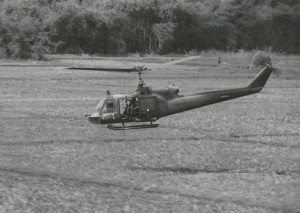 VC at our 4 o’clock! Hunting near Duc Hoa.
VC at our 4 o’clock! Hunting near Duc Hoa.
******
Little Lady Scott & CE SP/5 Rick Strickland.
******
Photograph of the first Razorbacks and the weapons they utilized.
******
The name game.
******
This is FIRE POWER! One of the minis working out.
******
Crew Chief Eric Anspaugh cleaning the contact points to insure the rockets would have adequate ignition. One of those “pain in the neck” jobs.
******
358, another lightship. She has a “cluster light” mounted. It consisted of 7 DC-3/C-47 landing lights mounted in a circle. It illuminated a much broader swath than a Xenon light.
******
Very rare night time shot. Shows the ground illuminated by a cluster light. Altitude is 100 feet AGL.
******
The 50 on the Firefly/Nighthawk.
******
The reflex sight for aiming where your rockets are needed to go.
******
358, the alternate lightship. Elaborate paint scheme on her.
******
The instrument panel for a Huey helicopter.
******
Copilot’s station in a Huey. Often Aircraft Commanders would claim the left seat for themselves.
******
Huey cockpit illuminated by the overhead map lights which had both clear & red lens. The red lens did not destroy your night vision like bright white lights do.
******
Mini-gun & rockets, anyone?
******
Door hog from ’67-’68.
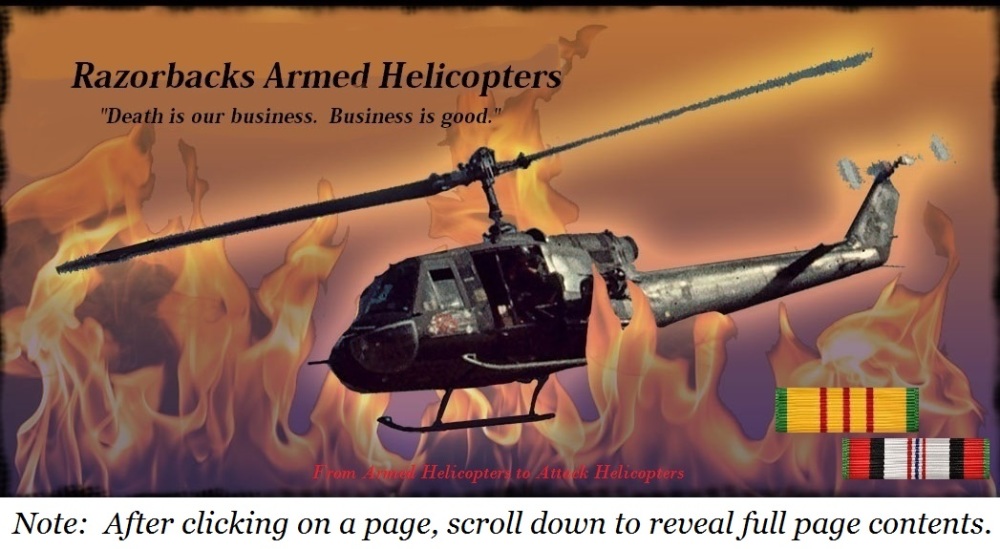

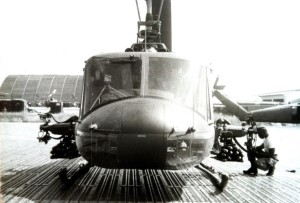

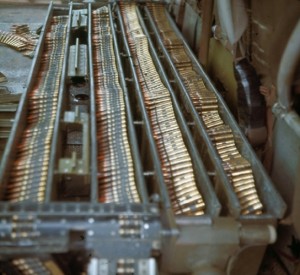
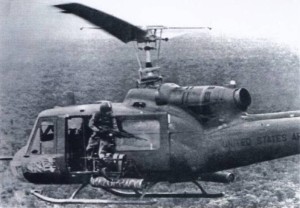
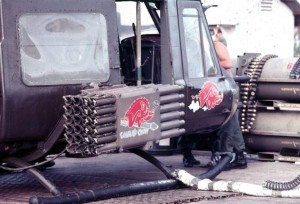
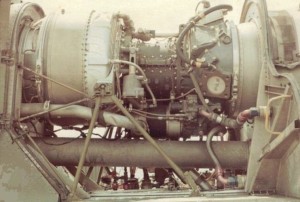
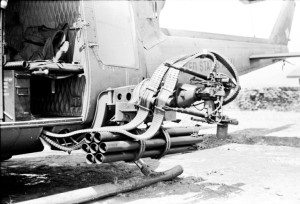

![rebateatt349[1]](http://razorbacksgunships.com/wp-content/uploads/2014/02/rebateatt3491-300x219.jpg)
